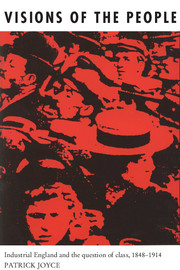Book contents
- Frontmatter
- Contents
- List of plates
- Acknowledgements
- 1 Introduction: beyond class?
- PART I POWER AND THE PEOPLE: POLITICS AND THE SOCIAL ORDER
- PART II MORALISING THE MARKET: WORK AND THE SOCIAL ORDER
- PART III CUSTOM, HISTORY, LANGUAGE: POPULAR CULTURE AND THE SOCIAL ORDER
- 6 Custom and the symbolic structure of the social order
- 7 The sense of the past
- 8 The people's English
- PART IV KINGDOMS OF THE MIND: THE IMAGINARY CONSTITUTION OF THE SOCIAL ORDER
- Appendices
- Bibliographical note
- Notes
- Index
6 - Custom and the symbolic structure of the social order
Published online by Cambridge University Press: 05 March 2012
- Frontmatter
- Contents
- List of plates
- Acknowledgements
- 1 Introduction: beyond class?
- PART I POWER AND THE PEOPLE: POLITICS AND THE SOCIAL ORDER
- PART II MORALISING THE MARKET: WORK AND THE SOCIAL ORDER
- PART III CUSTOM, HISTORY, LANGUAGE: POPULAR CULTURE AND THE SOCIAL ORDER
- 6 Custom and the symbolic structure of the social order
- 7 The sense of the past
- 8 The people's English
- PART IV KINGDOMS OF THE MIND: THE IMAGINARY CONSTITUTION OF THE SOCIAL ORDER
- Appendices
- Bibliographical note
- Notes
- Index
Summary
Consideration of how the social order was represented and understood requires attention to language. This is because language was at the centre of culture. To accord language this significance is today almost passé, though it must be said that in general historians have mostly paid only lip-service to its importance. The expanded sense of language as a sign system is explored in this chapter, culture here being interpreted as the codes of symbols people use to confer meaning and order on the world. However, a dominating concern with the semiotics of the non-verbal has until recently drawn attention from words. The fundamentally significant verbal character of language is therefore considered in chapter 8 in its broadest dimension of the national language itself.
This part begins, however, with a consideration of custom, using custom as one means of exploring the broader character of assumed, often unspoken knowledge of society. It soon becomes apparent how intimately custom was linked to the construction of the sense of the past. Custom was about the legitimation of social values and social practices, and this involved the deployment of the notion of precedent and hence of an historical sense. In the course of this period this sense interacted with more formal and conscious elaborations of history. Contemporary conceptions of language were in turn heavily historical in character (just as history turned much upon the idea of national histories being embedded in language and literature).
Information
- Type
- Chapter
- Information
- Visions of the PeopleIndustrial England and the Question of Class, c.1848–1914, pp. 145 - 171Publisher: Cambridge University PressPrint publication year: 1991
